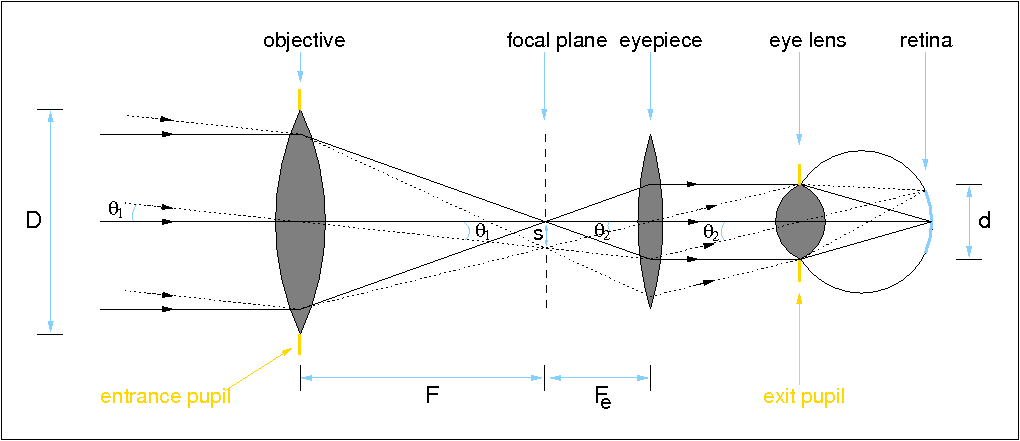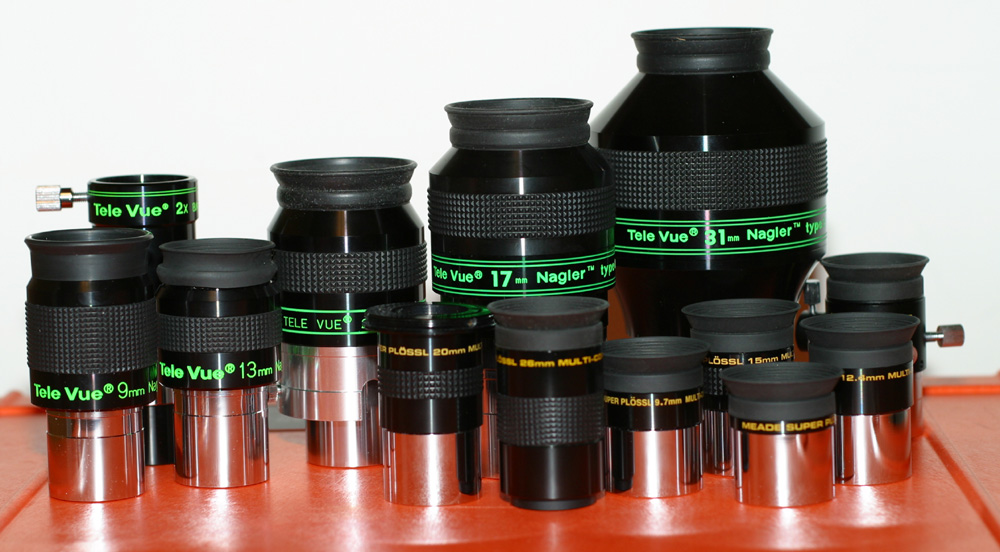| visual use of telescopes |
|
The role of the eyepiece and the eye
It is rarely possible to look through modern research telescopes with the eye. This is because observing time on them is so precious and because the eye is such a poor detector compared to the electronic equivalents. On the other hand, amateur telescopes are often used visually, in which case an eyepiece is required, as shown in figure 27.
| figure 27: |
Schematic of a refracting telescope, illustrating the role of the
eyepiece and the eye. The same concepts would apply if considering
a reflecting telescope.
|

The role of the eyepiece can be thought of as a magnifying glass which takes the diverging rays of light from each point in the focal plane and makes them parallel. The lens in the eye then focuses this parallel light, creating an image of the object on the retina which is the correct way up. However, since the brain inverts all images falling on the retina (if it didn't, the everyday world around us would look upside down!), the view in a telescope appears upside down. As can be seen from figure 27, the image recorded by an electronic detector placed at the focal plane of the objective would also appear upside down.
Looking in more detail at figure 27, it is useful to define the following terms: the entrance pupil is the area at the entrance of the telescope that can accept light. Clearly, in figure 27, this is defined by the objective lens. The exit pupil is the image of the entrance pupil formed by the eyepiece. Only rays which pass through the exit pupil can exit the system, and it therefore represents the optimum position for the eye when observing with a telescope. If the eye is placed closer or further away from the eyepiece than the exit pupil, not all the light gathered by the telescope will be collected by the eye. Light is also lost if the diameter of the exit pupil is greater than the size of the dark-adapted pupil of the eye, i.e. about 8mm. The distance of the last lens of the eyepiece to the exit pupil is known as the eye relief, and for comfortable viewing is usually designed to be around 10mm in an amateur telescope.
For simplicity, figure 27 assumes that the eyepiece (or ocular) is a single positive lens. We have already seen that such a lens would introduce chromatic aberration and hence combinations of lenses are often used. The simplest combinations, composed of two lenses, are the Huygens and Ramsden eyepieces. More complex, and expensive, eyepieces use three or more lenses and are able to provide better correction for chromatic aberration, wider aberration-free fields-of-view, and comfortable eye relief. Common designs are the Kellner, Orthoscopic, Plössl, Erfle and Nagler eyepieces, some of which are shown in figure 28.
| figure 28: |
Photograph of some
typical telescope eyepieces. There is a huge variety of designs,
with very different sizes and weights, and prices ranging from tens
of pounds to many hundreds.
|

Magnifying power
From figure 27, it can be seen that the
objective, of focal length F, focuses parallel
light to a point image in its focal plane; the eyepiece, of focal
length Fe, takes a point source in its
focal plane and converts it back to parallel light. Two distant
point sources separated by an angle ![]() 1 will produce two point images
separated by a distance s = F
1 will produce two point images
separated by a distance s = F ![]() 1 in the focal
plane of the objective and, since this is also the focal plane of the
eyepiece, the resulting two beams of parallel light will diverge
at an angle
1 in the focal
plane of the objective and, since this is also the focal plane of the
eyepiece, the resulting two beams of parallel light will diverge
at an angle ![]() 2 = s / Fe.
Hence, an observer looking through the eyepiece will see
parallel light from two sources separated by an angle
2 = s / Fe.
Hence, an observer looking through the eyepiece will see
parallel light from two sources separated by an angle
![]() 2 on the
sky. Without the help of the telescope, the eye would receive parallel light
from the two sources separated by an angle
2 on the
sky. Without the help of the telescope, the eye would receive parallel light
from the two sources separated by an angle
![]() 1. Therefore, since
1. Therefore, since
![]() 2 >
2 > ![]() 1, the image has
been magnified. Given that
s = F
1, the image has
been magnified. Given that
s = F ![]() 1
= Fe
1
= Fe ![]() 2, the
magnification (or magnifying power) of the
telescope/eyepiece combination is simply defined as:
2, the
magnification (or magnifying power) of the
telescope/eyepiece combination is simply defined as:
M =
![]() 2 /
2 /
![]() 1
= F / Fe.
1
= F / Fe.
When the magnification of a telescope is defined in this manner, it clearly only has any meaning when the telescope is being used with an eyepiece. Hence magnification is not a term used in the research vocabulary of professional astronomers, whose telescopes are never used visually. The term is relevant to the amateur astronomy market, of course, but it is often misused as the primary indicator of telescope performance. As we have seen, it is the diameter, focal length and telescope design which affect the performance of a telescope; the magnification is something which can be altered simply by using different eyepieces and is not an inherent property of the telescope.
Magnification limits
A further inspection of the on-axis rays in
figure 27 shows that
the triangle formed by the diameter of the objective, D, and
the image in the focal plane at a distance F
from the objective is similar to the triangle formed by the diameter of
the exit pupil at the eyepiece, d, and the image in the focal plane
at a distance Fe from the eyepiece, i.e.
D / d = F / Fe = M.
Hence an alternative way to express magnification is as the
ratio of the diameters of the objective and the exit pupil. This
naturally leads to a lower limit to the useful magnification of
a telescope; the magnification must be sufficiently high to make the
exit pupil equal to or smaller than the diameter of the dark-adapted pupil
of the eye, otherwise not all of the light collected by the telescope will
be gathered by the eye. This condition can be written as
M ≥ D / d,
where d is now the diameter of the eye's pupil.
Another lower limit to the useful magnification of a telescope can be
obtained by comparing
the resolving power
of the telescope to that of the eye. It is impossible to separate two
point sources by increasing the magnification if they are not resolved
in the focal plane. However, if the two point sources are resolved in
the focal plane, it is possible to use magnification to bring them
above the resolution limit of the human eye. Hence a lower limit to
the useful magnification of a telescope is the factor by which its
resolution,
![]() ,
needs to be multiplied by to make it equal to the resolution of the eye,
,
needs to be multiplied by to make it equal to the resolution of the eye,
![]() e;
any lower, and the full resolving power of the telescope is not being properly
exploited. This limit can be expressed mathematically as
e;
any lower, and the full resolving power of the telescope is not being properly
exploited. This limit can be expressed mathematically as
M ≥ ![]() e /
e /
![]() .
.
Assuming that the resolution of the telescope is limited by
diffraction,
and that the resolution of the eye is approximately four times its diffraction
limit (due to the relatively poor quality of the eye lens), this equation
can be rewritten as
M ≥
4 x (1.22![]() / d) /
(1.22
/ d) /
(1.22![]() / D)
= 4 D / d.
/ D)
= 4 D / d.
Assuming again that the diameter of the dark-adapted eye pupil,
d, is 8mm, we finally obtain
M ≥ D / 2,
where D is expressed in mm. Hence, matching the resolution of
the telescope to the resolution of the eye imposes a lower
magnification limit which is four times higher than that
imposed by the exit pupil diameter.
It is not possible to increase the magnification of a telescope
indefinitely by changing the eyepiece. Ultimately, magnification is
limited by the difficulty in making usable eyepieces of very short
focal length and by the progressive impairment of vision as the beam
that the eye accepts becomes smaller than about 1mm. Hence, using the
expression derived above for
the magnification of a telescope in terms
of the diameters of the objective and exit pupil, we get
M ≤ D,
where D is again expressed in
mm. Hence an 8-inch (200mm) reflector will have a useful upper
magnification limit of approximately 200.
An example problem shows how these magnification limits can be used in practice. It should be emphasized, however, that the magnification limits described here are only guides, and the actual limits of magnification depend on numerous factors, such as the characteristics of the astronomer's eye and telescope, the atmospheric conditions and the objects being observed.
Visual resolving power
The theoretical
resolving power, ![]() , of a telescope based on Rayleigh's criterion can be
written as
, of a telescope based on Rayleigh's criterion can be
written as
![]() ≈ 140 / D,
≈ 140 / D,
where ![]() is in arcseconds,
D is in mm, and we have assumed an observing wavelength of 550nm.
is in arcseconds,
D is in mm, and we have assumed an observing wavelength of 550nm.
A skilled observer, however, can actually resolve two stars which are
separated by an even smaller angle than given by this expression. This
is possible because an acute eye in good observing conditions can actually
detect a drop in the intensity between two close point sources of only
5%, whereas the drop in intensity implied by
Rayleigh's criterion is
20%. A number of alternatives to Rayleigh's theoretical criterion
have therefore been proposed, including Dawes empirical
criterion, which can be approximated by:
![]() ≈ 115 / D,
≈ 115 / D,
where ![]() is in arcseconds,
D is in mm and we have again assumed an observing wavelength of 550nm.
Hence Dawes' limit gives resolving powers which are about
20% better than Rayleigh's limit. Sparrow's limit is even smaller,
stating that it is possible to resolve objects even when they are separated
by half of the angle given by Rayleigh's criterion, although to do this
requires the use of electronic detectors and data analysis techniques to
search for the flat-topped intensity profile of the two closely-separated
point sources.
is in arcseconds,
D is in mm and we have again assumed an observing wavelength of 550nm.
Hence Dawes' limit gives resolving powers which are about
20% better than Rayleigh's limit. Sparrow's limit is even smaller,
stating that it is possible to resolve objects even when they are separated
by half of the angle given by Rayleigh's criterion, although to do this
requires the use of electronic detectors and data analysis techniques to
search for the flat-topped intensity profile of the two closely-separated
point sources.